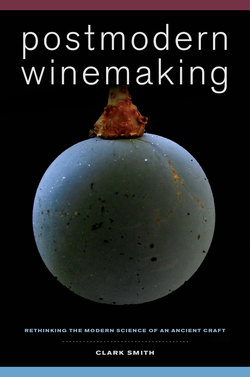Читать книгу Postmodern Winemaking - Clark Ashton Smith - Страница 16
На сайте Литреса книга снята с продажи.
Оглавление5
Vineyard Enology
The Power of Showing Up
Things should be made as simple as possible, and no simpler.
—Albert Einstein
Humans are not well equipped to look beyond the simple. In his masterpiece, The Quark and the Jaguar, Nobel laureate particle physicist Murray Gell-Mann examines the challenge of conceptualizing complex systems. It appears that one of the accomplishments of twenty-first-century science will be the development of tools for working with intricacies.
In the meantime, what we do instead is dissect complex reality into constituent parts that are easier to grasp, trying to manage the whole as the sum of the pieces. This is called reductionism. Though a poor substitute for a true grasp of the whole, reductionist rationalism often masquerades as the only legitimate form of scientific inquiry.
If we are honest with ourselves, rationalism must always be confessed a charade. When even a single atomic particle must be thought of as both a particle and a wave, and when hundreds of different dimers result from all the possible ways of linking just two identical tannin monomers, how can we hope ever to dissect the complexities that occur in a single glass of wine, let alone the natural chaos of a vineyard?
For the past half century, we have busied ourselves with the viticultural equivalent of ethnic cleansing. Our rational limitations manifest themselves in our cherished professional winegrowing practices, many of which are chosen primarily for their convenience to our way of thinking rather than to further what is best for wine, environment, or health. It is easier to conceive of and control a vineyard monoculture than a full-blown ecological system, and as soon as petrochemical pesticides and herbicides hit the market in the 1950s, many growers took to simplifying their task by eliminating every weed and bug. We then went on to abandon the practice of mixed cultivar plantings and to heat treat for viruses, further dumbing down the system.
The pursuit of orderliness is not the true face of science. Rather than conduct an inquiry into the complexities of natural balance, we bought ourselves time by changing the question from “What is the nature of a farm ecology?” to “What simplifying steps can I take to rationalize farming?” Another tactic in excluding extraneous input was to divide winegrowing into two academic disciplines: viticulture (the growing of grapes) and enology (the organized study of the making of wine).
The viticulture classes I took at UC Davis in the ’80s paid scant attention to wine grape quality. Our focus was on yields, pruning weights, acidity, and, above all, sugar (brix), all easily measured without resorting to the vagaries of aesthetics or sensory science. Often quoted in my UC Davis classes was Ray Kroc of McDonald’s: “You cannot manage what you cannot measure.” This training left viticulture graduates running commercial vineyards totally unprepared to debate quality with high-handed winemaker customers who want to drop half their crop to achieve flavor concentration.
I myself am a pitiful example of academic divide-and-conquer. In all candor, growing quality wine grapes requires all the attention a single individual can muster. You work it, breathe it, and dream it, awaking each morning with a new understanding. You can’t just phone it in. Knowing that I could never devote that much dedicated attention in my daily work, it has been my strategy to forge strong and lasting relationships with dedicated growers, and to try to hold up my end of an intense and continuous conversation about a win-win focused on quality.
Having come clean on this, I am nevertheless obliged in this book to touch on this most important of winemaking topics. Fortunately, I can in good conscience address postmodern approaches to the vineyard by introducing you to someone who’s really been there. While your typical winemaker will mouth the platitude that wine quality happens in the vineyard, Kay Bogart has actually walked the walk.
After fifteen years on the winemaking side at a string of gigs culminating at Opus One under Genevieve Janssens, in 1997 Kay approached the talented winemaker Mark Lyon of Sebastiani with a proposal to focus on vineyard work. But not as a viticulturalist. “Vineyard Enology,” as she termed it, focuses not on growing grapes but rather on making sure they contain the right ingredients to make the intended wine. Spotlight on the purple stuff, not the green stuff. What follows is largely what Kay worked out at that time and built on with my kibitzing while she directed the Vineyard Enology (VE) program at Vinovation from 2000 to 2005.
VE isn’t a prescribed methodology. It isn’t dogmatic about how the work is done, and is equally comfortable around conventional and organic/biodynamic producers. It also recognizes that what works in one site may fail in another. The focus is on results, which have at their source unique flavors of place, informed through a familiarity with wine structure, which depends for flavor depth and profundity on rich active tannin and maximum monomeric color. “Tannin is almost never the limiting factor in structural and color considerations,” opines Doug Adams of UC Davis, who has studied grape maturation for two decades. “The main issue to address is boosting color development so there is an optimal color to tannin ratio.”
